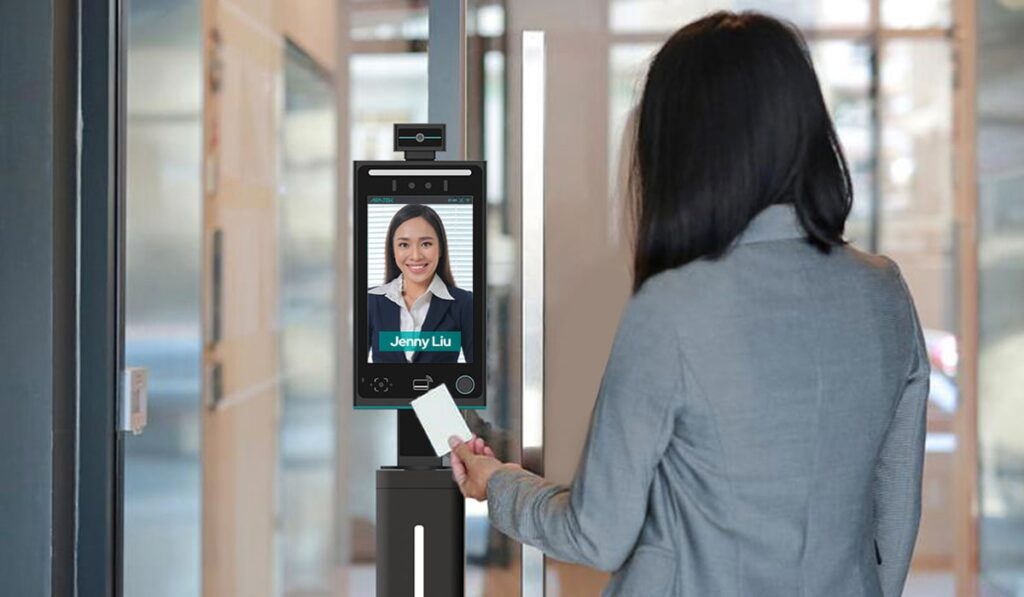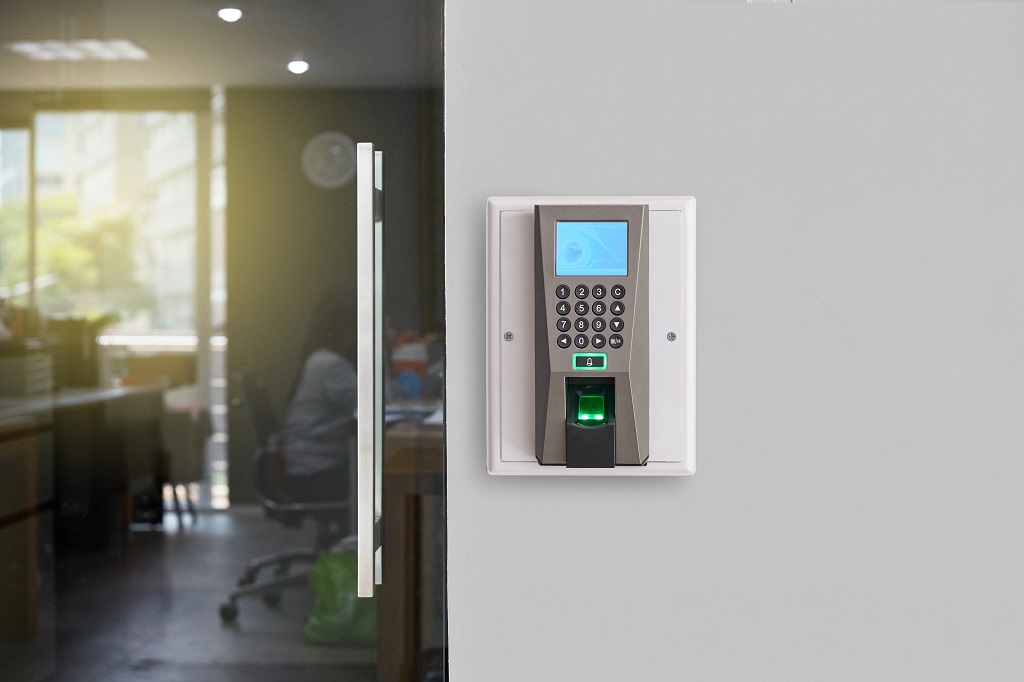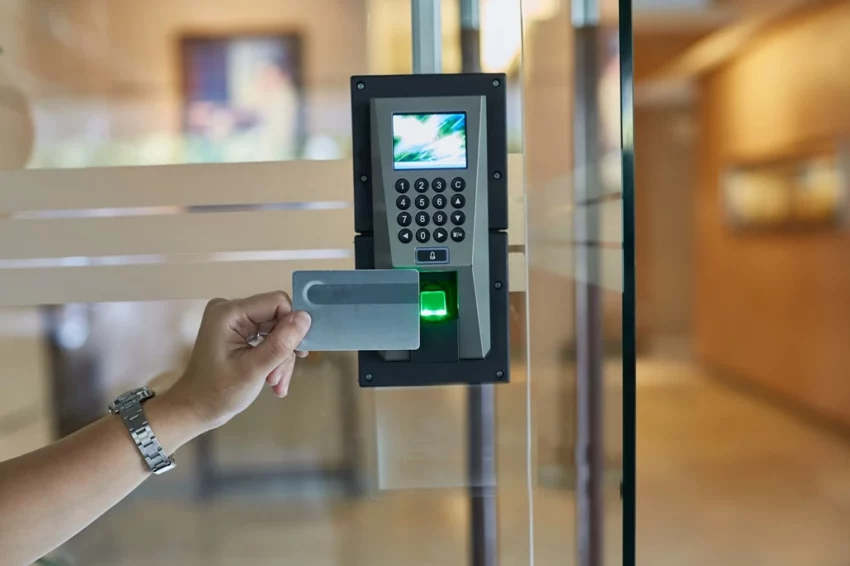Modern office security requires advanced solutions, making Access Control Door Systems a crucial investment for businesses. These sophisticated security systems manage entry points using electronic authentication methods such as key cards, biometric scanners, or PIN codes.
Office security goes beyond protecting physical assets – it also safeguards sensitive data, intellectual property, and most importantly, the individuals within the workspace. A strong access control system establishes a secure environment where employees can concentrate on their work without worrying about safety.
The implementation of an access control door system offers several benefits:
- Improved Security Management – Exact control over who can enter specific areas
- Comprehensive Access Tracking – Real-time monitoring of entry and exit activities
- Streamlined Operations – Removal of traditional key management
- Emergency Response – Quick lockdown capabilities during security threats
- Cost Efficiency – Decreased need for security personnel
- Flexible Access – Remote management of entry permissions
These systems represent a strategic approach to workplace security, blending state-of-the-art technology with practical functionality to create a safer, more efficient office environment.
The Importance of Security Systems in Offices
A strong security system is essential for keeping offices safe. It protects valuable assets, sensitive data, and employees from potential dangers. In today’s world, where workplaces are constantly evolving, it’s crucial to have advanced security solutions that work together seamlessly to create a powerful defence system.
Key Elements of an Effective Security System
An effective security system consists of several important parts:
- Intrusion Detection Systems: These are advanced sensors that can detect when someone tries to break into the office through doors, windows, or other entry points.
- Access Control Methods: This includes secure ways of allowing people into the office, such as using key cards, biometric scanners (like fingerprint or facial recognition), or PIN codes.
- Alarm Systems: These are immediate alert systems that go off when there’s a security breach. They can make loud noises to scare off intruders and also send silent notifications to security personnel.
- CCTV Surveillance: High-resolution cameras that monitor the office 24/7 and record everything happening on the premises.
- Back to Base Monitoring: Professional security teams who keep an eye on the office around the clock and can respond quickly if there’s an incident.
- Smart Integration: Unified control systems that connect all the different security components so they can work together efficiently.
Alpha Security Corp’s Expertise
With over 25 years of experience, Alpha Security Corp has successfully implemented these advanced security solutions for various clients. Their expertise includes:
- Custom system design tailored to specific office layouts
- Professional installation of integrated security components
- Ongoing technical support and maintenance services
- Staff training on how to operate the security system effectively
- Regular security audits and updates to ensure optimal performance
These combined security measures create multiple layers of protection within the office space. This ensures comprehensive coverage against different types of security threats while also allowing normal business operations to continue smoothly.
Enhanced Protection Against Unauthorized Access
Modern Intrusion Detection Systems (IDS) serve as vigilant digital guardians, employing sophisticated technology to safeguard office premises. These systems utilise multiple detection methods:
- Motion Sensors – Advanced infrared technology detects movement patterns and distinguishes between human presence and environmental factors
- Glass Break Detectors – Acoustic sensors identify specific frequencies associated with breaking glass
- Door Contact Sensors – Magnetic switches detect unauthorised door openings
- Pressure Mats – Hidden sensors identify footsteps in restricted areas
Access Control Methods add layers of security through various authentication technologies:
- Biometric Systems: Fingerprint scanners, facial recognition, retinal scanning, hand geometry readers
- Electronic Credentials: RFID cards, PIN codes, smart cards, mobile credentials
These systems create detailed audit trails of access attempts, tracking successful entries and failed attempts. The combination of IDS and Access Control creates a robust security framework that:
- Prevents tailgating attempts
- Restricts access to sensitive areas
- Identifies suspicious activity patterns
- Enables immediate response to security breaches
- Maintains detailed access logs
Integration with other security components allows for automated responses, such as triggering CCTV recordings or activating emergency protocols when unauthorised access is detected.
Quick Response Systems for Immediate Threats
Modern alarm systems are the quick response backbone of office security. These advanced systems go off immediately when they detect a security breach, setting off several response actions:
Immediate Audio-Visual Alerts
- High-decibel sirens to scare off intruders
- Strobe lights to confuse threats
- Mobile notifications to key personnel
Automated Emergency Protocols
- Direct connection to local police
- Instant lockdown of sensitive areas
- Activation of emergency exit routes
The combination of alarm systems with access control doors creates a strong security network that reacts within seconds to potential threats. When set off, these systems can:
- Automatically secure specific areas
- Generate real-time incident reports
- Activate emergency lighting systems
- Guide occupants to safety through pre-set protocols
A professional monitoring centre receives these alerts 24/7, evaluating the situation and sending the right emergency services. This quick response ability greatly decreases potential damage and ensures maximum protection for office assets and personnel.
Effective Monitoring and Surveillance Strategies
High-resolution CCTV surveillance cameras act as watchful digital eyes, providing comprehensive visual coverage of office premises 24/7. These advanced systems offer:
- Real-time monitoring capabilities through cloud-enabled platforms
- Mobile accessibility for remote viewing from smartphones or tablets
- High-definition footage capture for clear identification of individuals
- Night vision capabilities ensuring round-the-clock surveillance
- Motion detection technology to flag suspicious activities
Back to Base Monitoring: Professional Security Oversight
Back to Base Monitoring enhances the effectiveness of CCTV systems through professional security supervision. This service connects surveillance feeds to a dedicated control room staffed by trained security personnel who:
- Monitor live footage continuously
- Assess potential security threats
- Dispatch immediate response teams when needed
- Document and report suspicious activities
- Maintain detailed records of security events
The combination of CCTV surveillance and Back to Base Monitoring creates a strong security barrier that acts as a powerful deterrent against criminal activities. Would-be intruders are less likely to target premises with visible security cameras and professional monitoring systems in place.
Valuable Business Intelligence from Monitoring Strategies
These monitoring strategies also provide valuable business insights through:
- Access pattern analysis
- Foot traffic monitoring
- Operational efficiency assessment
- Health and safety compliance verification
- Evidence preservation for potential legal proceedings
Smart Integration for Advanced Security Measures
Smart integration is transforming traditional security systems by creating a smooth, connected network of security devices and controls. Modern access control door systems now work together with:
- Building automation systems
- Smart lighting controls
- HVAC (heating, ventilation, and air conditioning) systems
- Fire safety equipment
- Mobile applications
This integration allows for powerful automated responses to security incidents. When someone tries to gain unauthorized access, the system can:
- Trigger immediate lockdowns
- Activate security lighting
- Send instant mobile notifications to security personnel
- Start video recording
- Adjust building controls
Remote Management Capabilities
With remote management capabilities, authorized personnel can:
- Monitor the status of the system in real-time
- Grant or revoke access permissions instantly
- Review security logs from any location
- Receive customized alerts
- Control multiple facilities through a single interface
Enhanced Threat Detection with AI and Machine Learning
The integration of artificial intelligence (AI) and machine learning improves threat detection through:
- Pattern recognition
- Anomaly detection
- Predictive analytics
- Automated response protocols
These intelligent features create a proactive security environment that adapts to new threats while making day-to-day operations more efficient. The advancements in AI also enable more sophisticated algorithms for threat analysis and response, further enhancing the overall security framework.

Key Advantages of Implementing Access Control Door Systems in Offices
Access control door systems have completely changed office security with their advanced technology, making it easier for businesses to manage entry points and protect their assets. These systems offer several benefits that go beyond just basic security measures.
1. Enhanced Security Protocol Management
With access control systems, businesses can have better control over their security protocols. Here are some ways these systems help:
- Customisable access levels for different areas
- Instant activation/deactivation of access credentials
- Digital tracking of all entry attempts
- Real-time security breach notifications
2. Streamlined Personnel Movement
Access control systems make it easier for authorised personnel to move around the workplace without any disruptions. Instead of relying on traditional keys, staff members can use advanced identification methods such as:
- Proximity cards
- Biometric scanners
- Mobile credentials
- PIN codes
3. Flexible Work Environment Support
Modern access control systems are designed to accommodate various working patterns. This flexibility includes:
- 24/7 facility access for approved staff
- Temporary access provision for contractors
- Scheduled access restrictions
- Remote entry management
4. Automated Security Processes
By going digital with access control, businesses can eliminate manual security procedures and automate important tasks like:
- Automatic door locking schedules
- Pre-programmed holiday security protocols
- Visitor management automation
- Integration with time and attendance systems
5. Risk Reduction Capabilities
These systems play a crucial role in minimising security risks by:
- Preventing unauthorised key duplication
- Reducing human error in security protocols
- Creating digital audit trails
- Enabling immediate security policy updates
The technological advancement of access control systems creates a dynamic security environment that adapts to changing business needs. These systems provide granular control over who enters specific areas at particular times, creating a secure yet efficient workplace environment.
Access control technology transforms traditional security measures into intelligent systems that protect assets while facilitating smooth business operations. The integration of these systems with existing security infrastructure strengthens the overall security posture of any office environment.
Cost Savings and Return on Investment with Access Control Solutions
Access control door systems deliver substantial financial benefits through reduced operational costs and enhanced resource management. The elimination of physical key management generates immediate cost reductions:
- No expenses for key cutting and replacement
- Reduced locksmith service requirements
- Elimination of rekeying costs when employees leave
- Decreased security staff needs for manual access management
The integration of access control systems with building management infrastructure creates additional cost-saving opportunities:
Energy Efficiency Benefits:
- Automatic lighting control in restricted areas
- HVAC system optimization based on occupancy
- Power management for unused zones
- Smart scheduling of building systems
Risk Mitigation Savings:
- Lower insurance premiums due to enhanced security
- Reduced theft and property damage costs
- Minimized liability risks from unauthorized access
- Decreased investigation costs through detailed access logs
The return on investment extends beyond direct cost savings through improved operational efficiency. Digital access management eliminates time spent on key administration tasks, allowing staff to focus on core business activities. The system’s scalability accommodates business growth without requiring significant additional investment.
Modern access control solutions also reduce maintenance costs through remote troubleshooting capabilities and predictive maintenance alerts, ensuring optimal system performance while minimising downtime and repair expenses.
Monitoring, Reporting, and Compliance Support through Access Control Technology
Access control door systems are powerful tools for keeping track of workplace activity and meeting regulatory requirements. These systems automatically create detailed logs of every entry and exit, providing an unchangeable record of who goes in and out.
Advanced Monitoring Capabilities:
- Real-time tracking of employee movements
- Instant alerts for suspicious activities
- Digital timestamps for all access attempts
- Automated attendance recording
- Detailed visitor management logs
The system’s reporting features allow businesses to generate customised reports for various purposes:
- Time and attendance tracking
- Space utilisation analysis
- Security incident investigations
- Employee scheduling optimisation
- Compliance documentation
GDPR Compliance Benefits:
- Secure storage of personal data
- Controlled access to sensitive information
- Automated data retention policies
- Clear audit trails for data processing
- Built-in privacy protection measures
These strong monitoring capabilities help businesses meet strict regulatory requirements in different industries. The system’s ability to keep accurate, tamper-proof records is extremely valuable during external audits and internal investigations.
Access control technology makes compliance management easier by automating the processes of collecting and retaining data. Because these systems are digital, they eliminate human error in record-keeping and provide instant access to past data whenever it’s needed.
Emergency Management Capabilities Offered by Access Control Door Systems
Access control door systems play a crucial role in emergency response plans, providing advanced safety features that can be vital during critical situations.
Key Features of Access Control Door Systems in Emergencies
These systems enable:
- Instant Building-Wide Unlocking – A single command can unlock all doors simultaneously, allowing rapid evacuation
- Emergency Override Protocols – Automatic door release during fire alarms or power failures
- Zone-Based Control – Strategic unlocking of specific areas to create safe evacuation routes
- Integration with Fire Systems – Automatic response to fire alarm triggers
- Remote Emergency Access – Security personnel can control doors from safe locations
Importance of Data Logging in Emergency Management
The systems maintain detailed logs of emergency events, providing valuable data for:
- Post-incident analysis
- Emergency response evaluation
- Safety protocol refinement
- Compliance documentation
Advanced Features for Enhanced Security and Communication
Advanced features include:
- Fail-safe mechanisms ensuring doors remain operational during power outages
- Emergency responder access protocols
- Two-way communication systems at key entry points
- Backup power systems for continuous operation
These capabilities create a robust emergency management framework while preserving the security integrity of the facility during crisis situations. For a more comprehensive understanding of how to effectively plan for emergencies, you might find it beneficial to explore the guidelines provided by OSHA on emergency preparedness.
Multi-location Management Made Easy with Centralised Access Control Solutions
Centralised access control systems revolutionise security management for businesses with multiple office locations. A single, unified platform enables security administrators to:
- Monitor and control access across all premises from one dashboard
- Implement standardised security protocols company-wide
- Grant or revoke access permissions instantly for any location
- Generate comprehensive reports across the entire organisation
The system’s cloud-based architecture allows real-time synchronisation of access rights, ensuring consistent security measures across all sites. Security managers can:
- Track employee movements between different offices
- Set location-specific access restrictions
- Manage temporary access for visitors at any site
- Respond to security incidents from anywhere
This centralised approach eliminates the need for separate security systems at each location, reducing administrative overhead and potential security gaps. The streamlined management system proves particularly valuable for:
- Companies with interstate offices
- Organisations with international branches
- Businesses managing multiple facilities
- Enterprises with satellite offices
The integration capabilities enable businesses to maintain robust security standards while adapting to specific regional requirements or local regulations at each site.

Conclusion
Access control door systems transform office security into a powerful asset for modern businesses. These systems create a safer work environment through robust authentication methods and real-time monitoring. The enhanced operational oversight enables businesses to track access patterns, manage multiple locations, and respond swiftly to security incidents.
The implementation of access control solutions delivers substantial reduced costs through:
- Elimination of physical key management
- Integration with building management systems
- Decreased security personnel requirements
- Lower insurance premiums
The investment in an access control door system stands as a strategic decision that strengthens security, streamlines operations, and provides lasting value for any office environment.
See Also: How Access Control Systems can improve workplace safety.

